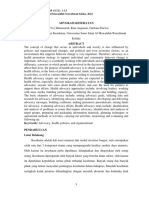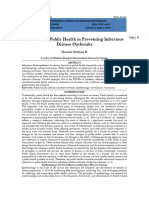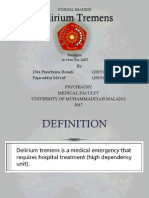Epidemiologic Mass Treatment 2014
Epidemiologic Mass Treatment 2014
Uploaded by
TivHa Cii Mpuzz MandjaCopyright:
Available Formats
Epidemiologic Mass Treatment 2014
Epidemiologic Mass Treatment 2014
Uploaded by
TivHa Cii Mpuzz MandjaOriginal Description:
Copyright
Available Formats
Share this document
Did you find this document useful?
Is this content inappropriate?
Copyright:
Available Formats
Epidemiologic Mass Treatment 2014
Epidemiologic Mass Treatment 2014
Uploaded by
TivHa Cii Mpuzz MandjaCopyright:
Available Formats
EPIDEMIOLOGIC MASS
TREATMENT
Dr Arulita Ika Fibriana M.Kes (Epid)
DEFINITION
Epidemiologic mass treatment is the
presumptive treatment of individuals
or populations with a high likelihood of
having disease.
Treatment is dependent not on the
presence of symptoms or signs, nor
on results of laboratory tests, but on
increased risk of exposure.
INTRODUCTION
A wide range of terminology : mass
treatment, selective mass treatment,
presumptive treatment, empiric
prophylaxis/treatment.
Mass treatment is the application of
epidemiologic treatment to general
populations based on high overall community
prevalence.
The more focused epidemiologic treatment of
higher-risk sub-populations (such as sex
workers, migrant workers or military) is
referred to herein as targeted presumptive
treatment.
Either population-based mass treatment or
targeted presumptive treatment can be
carried out once or periodically over time.
INTRODUCTION
Antibiotics or antimicrobial drugs can be
given on an epidemiologic basis to
treat presumed disease in persons at
risk of being infected (presumptive
treatment) or to prevent future infection
in persons with continued high levels of
exposure (prophylaxis treatment).
In practice, because exposure is
generally high in populations with high
prevalence, presumptive administration
of antibiotics probably has both
treatment and prophylactic effects.
Where accurate, affordable, rapid
diagnostics are available, individuals
can be selected for screening on
epidemiologic grounds, with treatment
reserved for those with positive results
Targeted screening and treatment
is related.
MASS TREATMENT ON
EPIDEMIOLOGICAL PRACTICE (STDs
CONTROL PROGRAM)
STD control strategy at healthcare
facilities is restricted by the extent to
which people recognize that they are
infected and present for care, as well as
by the availability of STD services and
resources to provide STD screening.
Most women, and many men, with STDs
are asymptomatic, and many of those
with symptoms may seek care in the
informal sector.
Age and ethnicity may affect access or
perceived access to health care.
MASS TREATMENT ON
EPIDEMIOLOGICAL PRACTICE (STDs
CONTROL PROGRAM)
Mass treatment addresses these
limitations by treating whole
populations (GENERAL
POPULATION APPROACH/
population-based mass treatment)
regardless of symptoms, clinical signs,
or healthcare-seeking behavior, and
therefore should have a significant
impact on the size of the disease
reservoir.
MASS TREATMENT ON
EPIDEMIOLOGICAL PRACTICE (STDs
CONTROL PROGRAM)
Targeted presumptive treatment takes a
different approach.
Core group theory argues that individuals are
not equal when it comes to STD
transmission.
Rates of partner change influence
susceptibility to infection and chance of
subsequent transmission, vary widely within
populations;
Most people have few partners, relatively low
risk of STD exposure, and limited opportunity
to transmit acquired infections to
susceptibles.
MASS TREATMENT ON
EPIDEMIOLOGICAL PRACTICE (STDs
CONTROL PROGRAM)
Core groups, on the other hand, are
defined as subgroups within the
population with rates of partner change
sufficient to maintain an STD
reproductive rate of greater than one ( A
reproductive rate greater than one in any
population group leads to epidemic
growth).
Bridging populations, (clients of sex
workers), assure continued transmission
between core and noncore groups.
Despite differences in approach, population-
based mass treatment and targeted
presumptive treatment strategies share the
same basic disease control objectives.
The primary objective has been to achieve a
rapid reduction in disease prevalence.
Therefore, epidemiologic treatment
strategies are temporary or emergency
measures.
To maintain reduced prevalence levels, other,
more sustainable, control measures, such as
primary prevention and improved case
management, must be in place.
Because of more frequent partner
change in the core, STD control
strategies that target core groups are
potentially much more efficient than
general population approaches.
Presumptive treatment of the most
epidemiologically important core
groups more cost-effective
approach to reducing STD prevalence
than general population mass
treatment.
You might also like
- First Aid of Common Emergencies in Outdoor Activities100% (3)First Aid of Common Emergencies in Outdoor Activities6 pages
- Skripsi Diana Novitadewi B - P07124214006No ratings yetSkripsi Diana Novitadewi B - P07124214006132 pages
- 8258 ID Mengembangkan Evidence Based Public Health Ebph Hiv Dan Aids Berbasis Surveilans100% (1)8258 ID Mengembangkan Evidence Based Public Health Ebph Hiv Dan Aids Berbasis Surveilans8 pages
- Hubungan Antara Sub Bidang Kesehatan Masyarakat-Meli PDFNo ratings yetHubungan Antara Sub Bidang Kesehatan Masyarakat-Meli PDF15 pages
- Tugas 4 Rahmatilla Perencanaan & Evaluasi Kesehatan Jurnal InternasionalNo ratings yetTugas 4 Rahmatilla Perencanaan & Evaluasi Kesehatan Jurnal Internasional2 pages
- Gambaran Penderita Filariasis Di Desa Sukoharjo, Wilayah Kerja Puskesmas Trimulyo, Kecamatan Sekampung, Kabupaten Lampung Timur Tahun 2020No ratings yetGambaran Penderita Filariasis Di Desa Sukoharjo, Wilayah Kerja Puskesmas Trimulyo, Kecamatan Sekampung, Kabupaten Lampung Timur Tahun 202011 pages
- Pengaruh Pengetahuan Dan Sikap Penderita Hipertensi Tentang Hipertensi Terhadap Keaktifan Dalam Kegiatan Prolanis Di Puskesmas Berastagi Kabupaten Karo Tahun 2017No ratings yetPengaruh Pengetahuan Dan Sikap Penderita Hipertensi Tentang Hipertensi Terhadap Keaktifan Dalam Kegiatan Prolanis Di Puskesmas Berastagi Kabupaten Karo Tahun 201710 pages
- Tugas Tutorial Epidemiologi M1.U3: Screening and Diagnostic TestNo ratings yetTugas Tutorial Epidemiologi M1.U3: Screening and Diagnostic Test9 pages
- Hubungan Pola Asuh Orang Tua Dengan Kejadian Diare Pada Balita Di Puskesmas Mergangsan Kota YogyakartaNo ratings yetHubungan Pola Asuh Orang Tua Dengan Kejadian Diare Pada Balita Di Puskesmas Mergangsan Kota Yogyakarta9 pages
- Understanding The Symptoms of The Common Cold and Influenza PDFNo ratings yetUnderstanding The Symptoms of The Common Cold and Influenza PDF8 pages
- Evaluasi Program Kesehatan Ibu Dan Anak Di100% (3)Evaluasi Program Kesehatan Ibu Dan Anak Di47 pages
- Advokasi Kesehatan: Jurnal Kesehatan USIMAR Vol (1) : 1-13 Universitas Sains Islam Al Mawaddah Warrahmah Kolaka, 2022No ratings yetAdvokasi Kesehatan: Jurnal Kesehatan USIMAR Vol (1) : 1-13 Universitas Sains Islam Al Mawaddah Warrahmah Kolaka, 202214 pages
- Experimental Studies (Field Trials, Community TrialsNo ratings yetExperimental Studies (Field Trials, Community Trials17 pages
- Jurnal Kesehatan Masyarakat (Journal of Public Health)No ratings yetJurnal Kesehatan Masyarakat (Journal of Public Health)2 pages
- TM 4 Six Building Blocks Dan Health SystemNo ratings yetTM 4 Six Building Blocks Dan Health System9 pages
- ID Faktor Faktor Yang Mempengaruhi PerilakuNo ratings yetID Faktor Faktor Yang Mempengaruhi Perilaku11 pages
- P4-S1-Surveilan Epid-Manajemen Sistem Surveilan Dan Kendali Mutu Data Surveilan (Autosaved)No ratings yetP4-S1-Surveilan Epid-Manajemen Sistem Surveilan Dan Kendali Mutu Data Surveilan (Autosaved)26 pages
- Hubungan Pola Asuh Ibu Dengan Kejadian Stunting Anak Usia 12-59 Bulan100% (1)Hubungan Pola Asuh Ibu Dengan Kejadian Stunting Anak Usia 12-59 Bulan6 pages
- Contoh Judul Jurnal Kesehatan Internasional100% (1)Contoh Judul Jurnal Kesehatan Internasional3 pages
- BAIQ CIPTA HARDIANTI 22010111140197 Lap - KTI Bab8 PDFNo ratings yetBAIQ CIPTA HARDIANTI 22010111140197 Lap - KTI Bab8 PDF17 pages
- Faktor-Faktor Yang Mempengaruhi Pelaksanaan Telemedicine: (Systematic Review)No ratings yetFaktor-Faktor Yang Mempengaruhi Pelaksanaan Telemedicine: (Systematic Review)14 pages
- Faktor-Faktor Risiko Penularan Hiv-Aids Pada Laki-LakiNo ratings yetFaktor-Faktor Risiko Penularan Hiv-Aids Pada Laki-Laki11 pages
- Penyelenggaraan Keamanan Pangan Sebagai Salah Satu Upaya Perlindungan Hak Masyarakat Sebagai KonsumenNo ratings yetPenyelenggaraan Keamanan Pangan Sebagai Salah Satu Upaya Perlindungan Hak Masyarakat Sebagai Konsumen19 pages
- Contoh Program Kemitraan Di Bidang Kesehatan: Kelompok 2No ratings yetContoh Program Kemitraan Di Bidang Kesehatan: Kelompok 210 pages
- Metode Skor Konsumsi Pangan Untuk Menila PDFNo ratings yetMetode Skor Konsumsi Pangan Untuk Menila PDF10 pages
- Joaquim Pinto, Lic - SP, M.M, M.MTSC, DR. Lidia Gomes SKM, MPH, Dr. Avelino Guterres Correia, MPH, Ministry of Health of Timor-Leste100% (1)Joaquim Pinto, Lic - SP, M.M, M.MTSC, DR. Lidia Gomes SKM, MPH, Dr. Avelino Guterres Correia, MPH, Ministry of Health of Timor-Leste7 pages
- Treatment, Prevention and Control of Intestinal Parasitic InfectionNo ratings yetTreatment, Prevention and Control of Intestinal Parasitic Infection49 pages
- And Through State And: Primary PreferableNo ratings yetAnd Through State And: Primary Preferable3 pages
- The Role of Public Health in Preventing Infectious Disease Outbreaks (WWW - Kiu.ac - Ug)No ratings yetThe Role of Public Health in Preventing Infectious Disease Outbreaks (WWW - Kiu.ac - Ug)4 pages
- Introduction To Epidemiology Dr. Abdikani Ali MbbsNo ratings yetIntroduction To Epidemiology Dr. Abdikani Ali Mbbs38 pages
- Alternative and Herbal Livestock Health Sourcebook100% (2)Alternative and Herbal Livestock Health Sourcebook164 pages
- Strong Tie:: Q1. Illustrate Granovetter Strenghth of Weak TiesNo ratings yetStrong Tie:: Q1. Illustrate Granovetter Strenghth of Weak Ties10 pages
- (DAILY CALLER OBTAINED) - Risky Research Review ActNo ratings yet(DAILY CALLER OBTAINED) - Risky Research Review Act43 pages
- A Comparative Study of Serum Ascorbate Between Newly Diagnosed Type 2 Diabetics and Long Standing Type 2 Diabetics On TreatmentNo ratings yetA Comparative Study of Serum Ascorbate Between Newly Diagnosed Type 2 Diabetics and Long Standing Type 2 Diabetics On Treatment4 pages
- Uploadsmybrochuresallianz 3H Cover BrochureNo ratings yetUploadsmybrochuresallianz 3H Cover Brochure11 pages
- A Study to Assess the Knowledge of Family Members Regarding the Prevention and Care of Hypertension among Elderly People Admitted in Medical Ward at B.V.V Sangha’s H.S.K Medical College and Research Center, Navanagar, Bagalkot, District KarnatakaNo ratings yetA Study to Assess the Knowledge of Family Members Regarding the Prevention and Care of Hypertension among Elderly People Admitted in Medical Ward at B.V.V Sangha’s H.S.K Medical College and Research Center, Navanagar, Bagalkot, District Karnataka7 pages
- Science4 - Q2 - Mod2 - Causes and Treatment of Diseases of The Major Organs - ABRIDGEDNo ratings yetScience4 - Q2 - Mod2 - Causes and Treatment of Diseases of The Major Organs - ABRIDGED8 pages
- Hockenberry: Wong's Essentials of Pediatric Nursing, 9th EditionNo ratings yetHockenberry: Wong's Essentials of Pediatric Nursing, 9th Edition5 pages
- Biron - Birkbeck Institutional Research Online: Downloaded FromNo ratings yetBiron - Birkbeck Institutional Research Online: Downloaded From9 pages
- First Aid of Common Emergencies in Outdoor ActivitiesFirst Aid of Common Emergencies in Outdoor Activities
- 8258 ID Mengembangkan Evidence Based Public Health Ebph Hiv Dan Aids Berbasis Surveilans8258 ID Mengembangkan Evidence Based Public Health Ebph Hiv Dan Aids Berbasis Surveilans
- Hubungan Antara Sub Bidang Kesehatan Masyarakat-Meli PDFHubungan Antara Sub Bidang Kesehatan Masyarakat-Meli PDF
- Tugas 4 Rahmatilla Perencanaan & Evaluasi Kesehatan Jurnal InternasionalTugas 4 Rahmatilla Perencanaan & Evaluasi Kesehatan Jurnal Internasional
- Gambaran Penderita Filariasis Di Desa Sukoharjo, Wilayah Kerja Puskesmas Trimulyo, Kecamatan Sekampung, Kabupaten Lampung Timur Tahun 2020Gambaran Penderita Filariasis Di Desa Sukoharjo, Wilayah Kerja Puskesmas Trimulyo, Kecamatan Sekampung, Kabupaten Lampung Timur Tahun 2020
- Pengaruh Pengetahuan Dan Sikap Penderita Hipertensi Tentang Hipertensi Terhadap Keaktifan Dalam Kegiatan Prolanis Di Puskesmas Berastagi Kabupaten Karo Tahun 2017Pengaruh Pengetahuan Dan Sikap Penderita Hipertensi Tentang Hipertensi Terhadap Keaktifan Dalam Kegiatan Prolanis Di Puskesmas Berastagi Kabupaten Karo Tahun 2017
- Tugas Tutorial Epidemiologi M1.U3: Screening and Diagnostic TestTugas Tutorial Epidemiologi M1.U3: Screening and Diagnostic Test
- Hubungan Pola Asuh Orang Tua Dengan Kejadian Diare Pada Balita Di Puskesmas Mergangsan Kota YogyakartaHubungan Pola Asuh Orang Tua Dengan Kejadian Diare Pada Balita Di Puskesmas Mergangsan Kota Yogyakarta
- Understanding The Symptoms of The Common Cold and Influenza PDFUnderstanding The Symptoms of The Common Cold and Influenza PDF
- Advokasi Kesehatan: Jurnal Kesehatan USIMAR Vol (1) : 1-13 Universitas Sains Islam Al Mawaddah Warrahmah Kolaka, 2022Advokasi Kesehatan: Jurnal Kesehatan USIMAR Vol (1) : 1-13 Universitas Sains Islam Al Mawaddah Warrahmah Kolaka, 2022
- Experimental Studies (Field Trials, Community TrialsExperimental Studies (Field Trials, Community Trials
- Jurnal Kesehatan Masyarakat (Journal of Public Health)Jurnal Kesehatan Masyarakat (Journal of Public Health)
- P4-S1-Surveilan Epid-Manajemen Sistem Surveilan Dan Kendali Mutu Data Surveilan (Autosaved)P4-S1-Surveilan Epid-Manajemen Sistem Surveilan Dan Kendali Mutu Data Surveilan (Autosaved)
- Hubungan Pola Asuh Ibu Dengan Kejadian Stunting Anak Usia 12-59 BulanHubungan Pola Asuh Ibu Dengan Kejadian Stunting Anak Usia 12-59 Bulan
- BAIQ CIPTA HARDIANTI 22010111140197 Lap - KTI Bab8 PDFBAIQ CIPTA HARDIANTI 22010111140197 Lap - KTI Bab8 PDF
- Faktor-Faktor Yang Mempengaruhi Pelaksanaan Telemedicine: (Systematic Review)Faktor-Faktor Yang Mempengaruhi Pelaksanaan Telemedicine: (Systematic Review)
- Faktor-Faktor Risiko Penularan Hiv-Aids Pada Laki-LakiFaktor-Faktor Risiko Penularan Hiv-Aids Pada Laki-Laki
- Penyelenggaraan Keamanan Pangan Sebagai Salah Satu Upaya Perlindungan Hak Masyarakat Sebagai KonsumenPenyelenggaraan Keamanan Pangan Sebagai Salah Satu Upaya Perlindungan Hak Masyarakat Sebagai Konsumen
- Contoh Program Kemitraan Di Bidang Kesehatan: Kelompok 2Contoh Program Kemitraan Di Bidang Kesehatan: Kelompok 2
- Joaquim Pinto, Lic - SP, M.M, M.MTSC, DR. Lidia Gomes SKM, MPH, Dr. Avelino Guterres Correia, MPH, Ministry of Health of Timor-LesteJoaquim Pinto, Lic - SP, M.M, M.MTSC, DR. Lidia Gomes SKM, MPH, Dr. Avelino Guterres Correia, MPH, Ministry of Health of Timor-Leste
- Treatment, Prevention and Control of Intestinal Parasitic InfectionTreatment, Prevention and Control of Intestinal Parasitic Infection
- The Role of Public Health in Preventing Infectious Disease Outbreaks (WWW - Kiu.ac - Ug)The Role of Public Health in Preventing Infectious Disease Outbreaks (WWW - Kiu.ac - Ug)
- Introduction To Epidemiology Dr. Abdikani Ali MbbsIntroduction To Epidemiology Dr. Abdikani Ali Mbbs
- Alternative and Herbal Livestock Health SourcebookAlternative and Herbal Livestock Health Sourcebook
- Strong Tie:: Q1. Illustrate Granovetter Strenghth of Weak TiesStrong Tie:: Q1. Illustrate Granovetter Strenghth of Weak Ties
- (DAILY CALLER OBTAINED) - Risky Research Review Act(DAILY CALLER OBTAINED) - Risky Research Review Act
- A Comparative Study of Serum Ascorbate Between Newly Diagnosed Type 2 Diabetics and Long Standing Type 2 Diabetics On TreatmentA Comparative Study of Serum Ascorbate Between Newly Diagnosed Type 2 Diabetics and Long Standing Type 2 Diabetics On Treatment
- A Study to Assess the Knowledge of Family Members Regarding the Prevention and Care of Hypertension among Elderly People Admitted in Medical Ward at B.V.V Sangha’s H.S.K Medical College and Research Center, Navanagar, Bagalkot, District KarnatakaA Study to Assess the Knowledge of Family Members Regarding the Prevention and Care of Hypertension among Elderly People Admitted in Medical Ward at B.V.V Sangha’s H.S.K Medical College and Research Center, Navanagar, Bagalkot, District Karnataka
- Science4 - Q2 - Mod2 - Causes and Treatment of Diseases of The Major Organs - ABRIDGEDScience4 - Q2 - Mod2 - Causes and Treatment of Diseases of The Major Organs - ABRIDGED
- Hockenberry: Wong's Essentials of Pediatric Nursing, 9th EditionHockenberry: Wong's Essentials of Pediatric Nursing, 9th Edition
- Biron - Birkbeck Institutional Research Online: Downloaded FromBiron - Birkbeck Institutional Research Online: Downloaded From

























































































